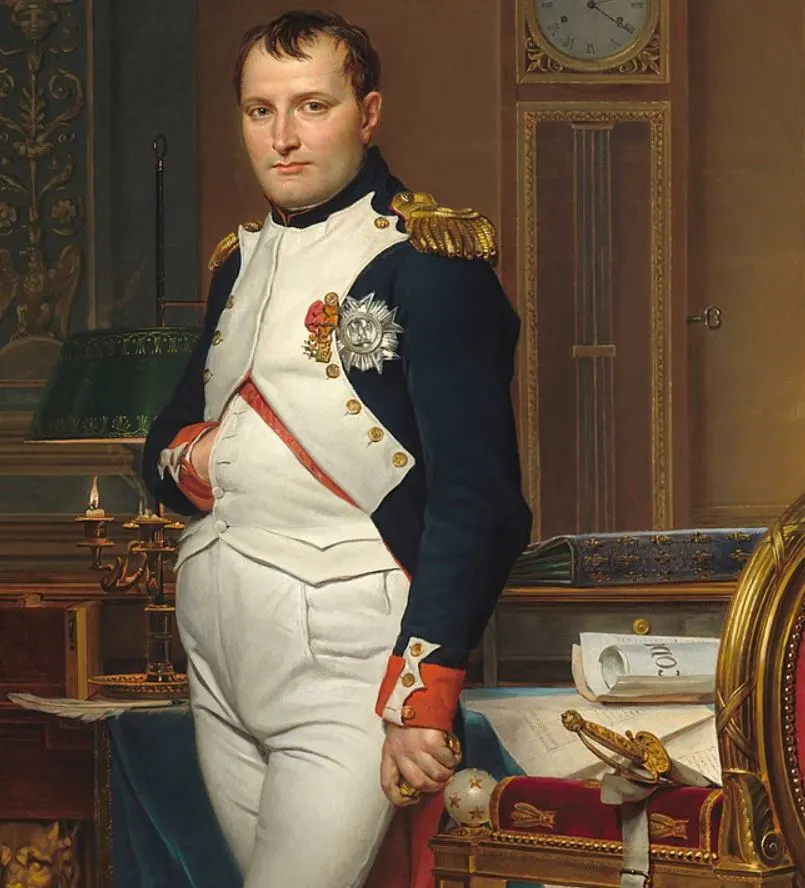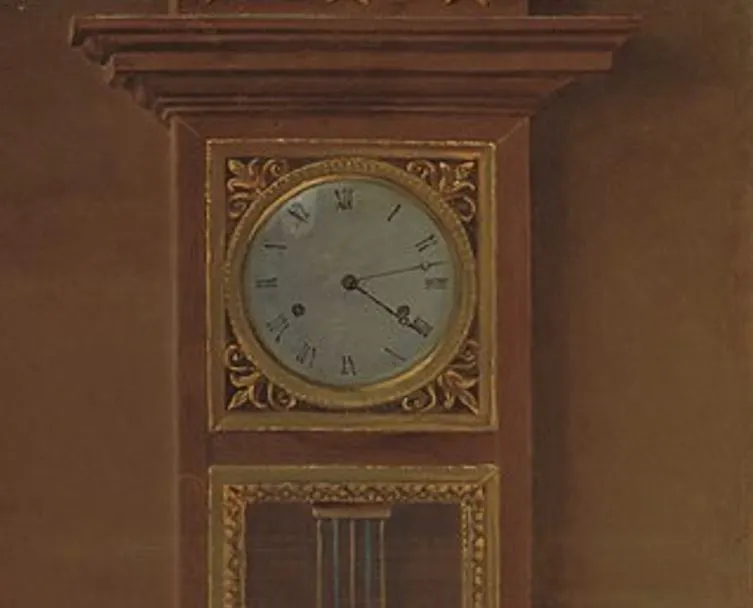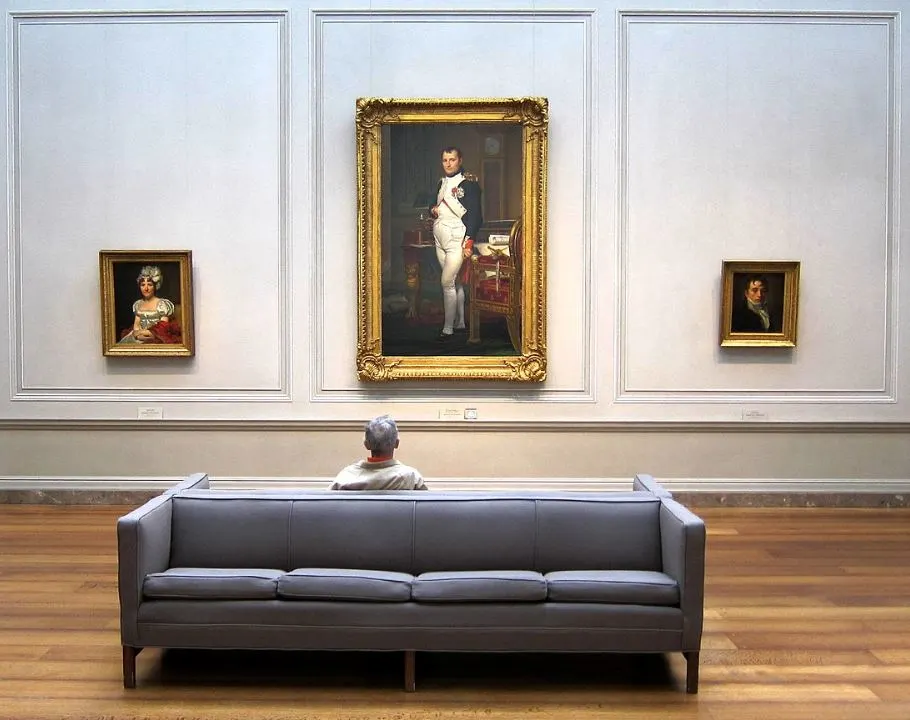Very few painters in history spent more time in the presence of Napoleon Bonaparte, the military leader who became Emperor of the French in the early 19th century than this French artist.
Jacques-Louis David (1748-1825) was a fervent supporter of the French Revolution and his talent brought him to the highest levels of French society.
He became the official court painter of the French Emperor in 1804, about 7 years after he first met this controversial figure in European history. He produced several Napoleon paintings shortly after.
In this article, you’ll discover some of the most interesting facts about a painting titled Emperor Napoleon in his Study at the Tuileries, one of David’s greatest paintings.
1. It was completed during the final years of Napoleon’s reign
It’s fair to describe Jacques-Louis David, the leading Neoclassical artist of his time, as one of the most politically involved artists in history.
He didn’t merely support the French Revolution in the 1790s, he was actively involved in it and even voted in the National Convention for the execution of King Louis XVI.
He became friends with Robespierre, a controversial figure who led the Reign of Terror, and this friendship nearly cost him his own life.
After a brief period of imprisonment, he aligned with the new political heavyweight, Napoleon Bonaparte. He met the French leader in 1797 and this was the first time he made a sketch of the man.
His most notable work while he was the official court painter of the regime was “The Coronation of Napoleon.”

He completed “Emperor Napoleon in His Study at the Tuileries” in 1812, just a few years before Napoleon’s fall in 1814.

2. It depicts the French Emperor wearing a particular uniform and decorations
The painting depicts the French Emperor in his private quarters at the Tuileries Palace in central Paris.
He wears a uniform that was typically worn by a colonel of the Imperial Guard Foot Grenadiers. This is highlighted by the blue and white colors and red cuffs.
He stands upright while facing the viewer and his hand in his waistcoat. Napoleon was often depicted in this pose which was an indication of calm and collected leadership.
Other remarkable elements are the gold epaulettes on his uniform and his Légion d’honneur and Order of the Iron Crown decorations on his chest.

3. The palace in which this scene takes place was destroyed during the early 1870s
The study in which Napoleon stands was located at the Tuileries Palace, a former royal palace that once stood on the right bank of the River Seine in central Paris.
It was located right next to the Louvre until it was burned down during the Paris Commune in 1871. Today, the large Tuileries Garden is located where the palace once stood.
The palace was originally completed in 1564 but expanded several times throughout its history. After all, it served as the official royal residence of French monarchs until it was destroyed.

4. Several elements imply that Napoleon had been up working all night
The French Emperor looks a bit rough, and this wasn’t because he was disorganized. He was depicted as such on purpose by David to imply that he had been working hard.
Several papers, books, dossiers, and other elements usually found in a study, were added near the Emperor. One of these features David’s signature which states “LVDci DAVID OPVS 1812.”
The most prominent word on the papers is the word “CODE.” David added these to imply that Napoleon had been working on the “Code Napoléon,” the French civil code that had been established in 1804.
David also placed a sword on the chair’s armrest, a reference to Napoleon’s military successes.

5. David made several changes to the overall composition after the initial draft
The candlelight already makes us assume that the scene takes place at night, but David made a remarkable change that makes it a certainty.
Napoleon was originally flanked by two columns, but these had about the same width as Napoleon himself. He rightfully figured that these were too distracting.
He changed these elements after the initial draft by adding a craved panel in the shadow on the left, and a large clock on the right.
The clock shows the time, 4:13 in the morning, something that further indicates that napoleon had been busy all night to get his empire the rails.

6. The painting wasn’t commissioned by Napoleon but by a Scottish Duke
Napoleon orally commissioned his coronation painting, but this wasn’t the case with this remarkable full-length portrait of the French Emperor.
Better yet, it’s likely that Napoleon never even posed for this painting because he was too busy with his conquest of Europe at the time to have been present.
The painting was commissioned by Alexander Hamilton, 10th Duke of Hamilton, 7th Duke of Brandon (1767-1852), a Scottish nobleman and politician.
He made it no secret that he was a great admirer of Napoleon and as an avid art collector, a portrait of his hero couldn’t be left out of his fine collection of art.

7. How big is Emperor Napoleon in His Study at the Tuileries?
The full-length portrait of Napoleon isn’t life-sized but rather three-quartes in length. It’s still an impressive depiction of the French Emperor.
Emperor Napoleon in His Study at the Tuileries by Jacques-Louis David is an oil on canvas painting that has dimensions of 203.9 × 125.1 centimeters (80.3 × 49.3 inches).

8. Where is Jacques-Louis David’s masterpiece located today?
The painting was hung at Hamilton Palace, a former country house at Hamilton, South Lanarkshire, Scotland, which served as the official seat of the Dukes of Hamilton.
The painting didn’t witness the demolition of Hamilton Palace between 1921 and 1926 after coal was discovered underneath it. It was sold to Archibald Primrose, 5th Earl of Rosebery in 1882.
The heirs of the Earl eventually sold the painting to the Samuel H. Kress Foundation in 1954 which donated it to the National Gallery of Art in Washington D.C.
Today, you can still admire this painting at Gallery 41 of the West Building in this popular museum in the capital city of the United States.

